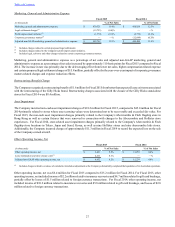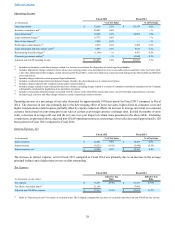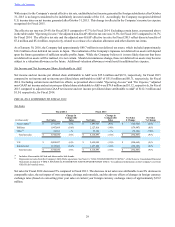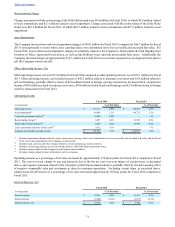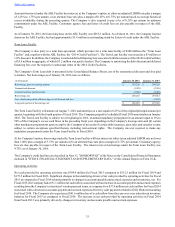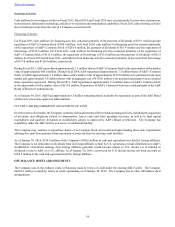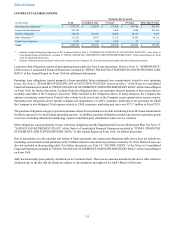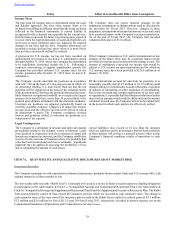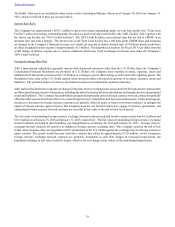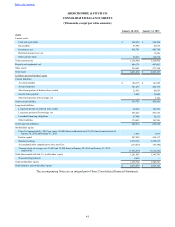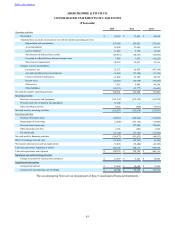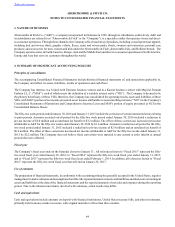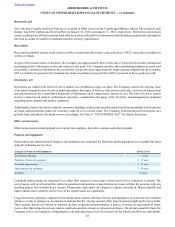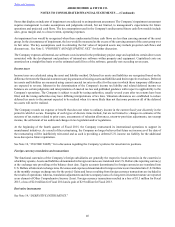Abercrombie & Fitch 2015 Annual Report Download - page 37
Download and view the complete annual report
Please find page 37 of the 2015 Abercrombie & Fitch annual report below. You can navigate through the pages in the report by either clicking on the pages listed below, or by using the keyword search tool below to find specific information within the annual report.
Table of Contents
37
The Company believes the following policies are the most critical to the portrayal of the Company’s financial condition and results
of operations.
Policy Effect if Actual Results Differ from Assumptions
Revenue Recognition
The Company reserves for sales returns through estimates based
on historical returns experience, recent sales activity and
various other assumptions that management believes to be
reasonable.
The Company has not made any material changes in the
accounting methodology used to determine the sales return
reserve over the past three fiscal years.
The Company does not expect material changes to the
underlying assumptions used to measure the sales return reserve
as of January 30, 2016. However, actual results could vary from
estimates and could result in material gains or losses.
Inventory Valuation
The Company reviews inventories on a quarterly basis. The
Company reduces the inventory valuation when the carrying
cost of specific inventory items on hand exceeds the amount
expected to be realized from the ultimate sale or disposal of the
goods, through a lower of cost or market ("LCM") adjustment.
The valuation reserve is established to reduce inventory to its
net realizable value based on the Company's consideration of
multiple factors and assumptions including demand forecasts,
current sales volumes, expected sell-off activity, composition
and aging of inventory, historical recoverability experience and
risk of obsolescence from changes in economic conditions or
customer preferences.
The Company does not expect material changes to the
underlying assumptions used to measure the shrink reserve or
the LCM reserve as of January 30, 2016. However, actual results
could vary from estimates and could significantly impact the
ending inventory valuation at cost, as well as gross margin.
An increase or decrease in the LCM reserve of 10% would have
affected pre-tax income by approximately $2.0 million for
Fiscal 2015.
Additionally, as part of inventory valuation, an inventory shrink
estimate is made each quarter that reduces the value of inventory
for lost or stolen items, based on sales volumes, average unit
costs, historical losses and actual shrink results from previous
physical inventories.
An increase or decrease in the inventory shrink accrual of 10%
would have affected pre-tax income by approximately $1.1
million for Fiscal 2015.
Long-lived Assets
Long-lived assets, primarily comprised of leasehold
improvements, furniture, fixtures and equipment, are tested for
recoverability whenever events or changes in circumstances
indicate that the carrying amount of the long-lived asset might
not be recoverable. These include, but are not limited to,
material declines in operational performance, a history of
losses, an expectation of future losses, other than temporary
adverse market conditions and store closure or relocation
decisions. On at least a quarterly basis, the Company reviews
for indicators of impairment at the individual store level, the
lowest level for which cash flows are identifiable.
Impairment loss calculations involve uncertainty due to the
nature of the assumptions that management is required to make,
including estimating projected cash flows and selecting the
discount rate that best reflects the risk inherent in future cash
flows. If actual results are not consistent with the estimates and
assumptions used, there may be a material impact on the
Company's financial condition or results of operation.
As of January 30, 2016, stores that were tested for impairment
and not impaired had a net book value of $7.6 million and had
undiscounted cash flows which were in the range of 100% to
150% of their respective net asset values.
Stores that display an indicator of impairment are subjected to
an impairment assessment. The Company’s impairment
assessment requires management to make assumptions and
judgments related, but not limited, to management's
expectations for future operations and projected cash flows. The
key assumptions used in the Company's undiscounted future
cash flow models include sales, gross margin and, to a lesser
extent, operating expenses.
An impairment loss would be recognized when these
undiscounted future cash flows are less than carrying amount
of the asset group. In the circumstance of impairment, the loss
would be measured as the excess of the carrying amount of the
asset group over its fair value. The key assumptions used in
estimating the fair value of impaired assets may include
projected cash flows and discount rate.
For stores assessed by management as having indicators of
impairment, a 10% decrease in the sales assumption used to
project future cash flows in the impairment testing performed
as of January 30, 2016 would have increased the Fiscal 2015
impairment charge by an insignificant amount.


